Transitional-style dining rooms are the way forward - inviting, elegant, perfect. Here's how to get them right
By strategically balancing contrast and cohesion, transitional- style dining rooms are calm yet full of personality. Designers explain why these 10 are so wonderful to eat in
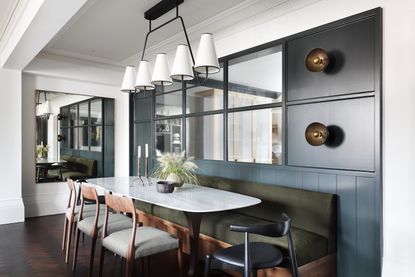
From curvaceous cornicing paired with sharp, mid century furnishings, to modern mirrors set above antique mantels, transitional style design is everywhere right now.
“The transitional style is about integrating different eras and styles into modern design, so that rooms feel like they have organically grown, rather than everything being bought brand new,” say Natalie Forbes and Louisa Rox, Co-Founders of Forbes Rix Design.
When done right, mixing old and new achieves a harmonizing, inviting and timeless effect. “Transitional style is a relaxed, calm aesthetic where traditional furniture and décor sits effortlessly alongside contemporary pieces,” says Clare Morton, Founder of Studio Morton. “Colors are neutral - think whites, creams, blacks and timber finishes. Sofas and armchairs are soft and comfortable, antique tables and cabinets make a quiet statement, and contemporary pieces - lighting, accent tables are either plain and simple or slightly harder and more graphic looking, adding interest and punctuation points.”
Transitional design works beautifully in a dining room, where there is plenty of opportunity to incorporate antique furniture. But achieving the style can be harder than it looks, as contrasting items must feel part of the same whole. Our experts share 10 tips for creating harmony in your transitional style dining room.
10 tips for creating a transitional style dining room
1. Follow the 60:40 rule

Like with minimalist dining rooms, choosing the right mix of furniture is key in order to achieve balance in your transitional space. “Proportions are crucial,” says Matteo Bianchi, Founder and Director of Matteo Bianchi. “Make sure if you’re balancing the proportions of the different finishes that you’ve chosen. Somehow you must make sure that these pieces ‘look’ the same, that they complement each other regardless of the era they come from.”
If you’re nervous about going on pure instinct, you can try taking a more mathematical approach. “I suggest applying the 60:40 rule where one style is slightly more prevalent and the other can act as an accent,” says Clare Morton. “My preference would be 60% traditional and 40% modern: traditional pieces can be bigger and bulkier, naturally taking up more space, whereas modern pieces are smaller and lighter. It’s best to work with the inherent qualities of the furniture.”
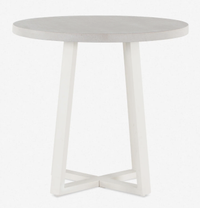
Hollis dining table, Lulu and Georgia
This unobtrusive round dining table is ideal to slot into a transitional space. It's slender and sleek, meaning the bulkier trad pieces have plenty of room to take up space around it.
2. Think in terms of yin and yang

Another trick to creating harmony is to partner up different items in your dining room, so that each piece is balanced out by another in the room.
“I'd work in pairs when selecting pieces. That way, you can ensure that no matter the ‘clash’ of styles, there is always a ying and a yang. i.e. dining table vs chairs, pendant vs wall light, curtains and window treatments vs wall color,” says Christian Bense, Founder of Christian Bense. “In any transitional style room, one needs to know how to edit, because traditional style is just as much about the careful consideration of the pieces being used as it is mixing pieces from different style groups.”
3. Always find a link between pieces
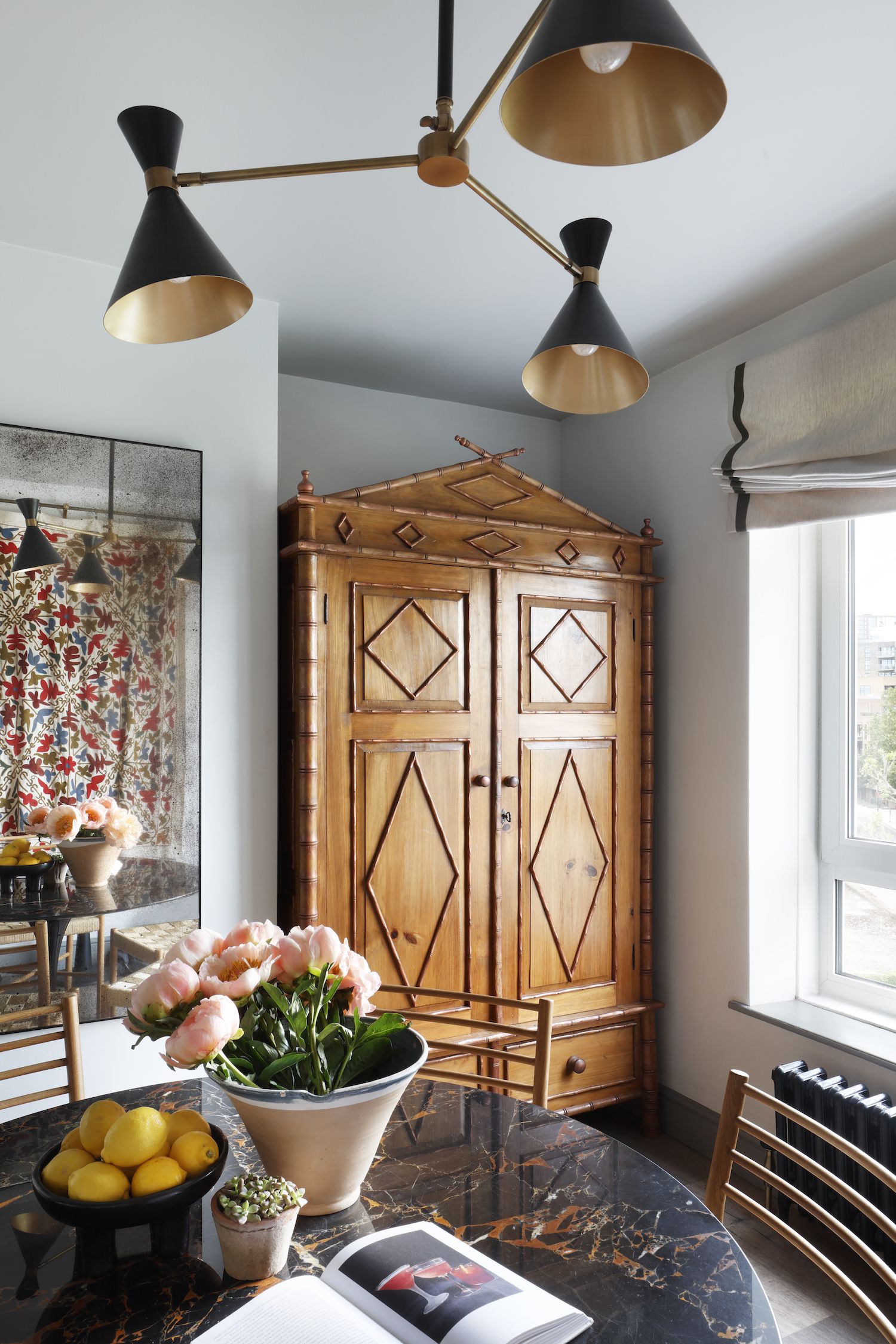
Importantly, transitional style is about bringing contrasting aesthetics together in a way that feels cohesive overall. “There does need to be some consistency, and one does need to be able to find a link between elements regardless of their style,” says Christian Bense. “It’s like a group of friends who all meet at college. They might be from all corners of the globe and have different hobbies, but they all came to study linguistics, and that’s why they are now friends. Make sure to find that link.”
Christian Bense continues: “For example, in the small dining room above, there are links between the tome of wood between the armchairs, which are Scandinavian design in style, and the wardrobe which is trad. The seat pattern in the weave of the chairs, picks up the checkerboard pattern used in the kitchen tiles. The brown grain in the marble table, picking up the brown in the timber floor. Find a link and the room will work.”
4. Don’t crowd the room

As you’re welcoming in furniture from different eras, it can be easy to get carried away and end up over-stuffing your dining room.
“What are the most important things to consider when choosing furniture from different eras?” says Christian Bense. “Balance, composition and scale always. I find it best not to crowd a room when mixing furniture from different decades, so you need to pay careful attention to how each piece fills the space. Like Cinderella’s glass slipper, if it doesn’t physically fit, she’s not right. One can really go wild when designing, when each piece is the appropriate size, creates balance and you keep the overall composition of the room clear.”
This is where dining table trends come in, with the soft modern shapes that are in style right now blending well with more traditional forms.
5. Use color and texture to create cohesion

Color and texture are two key tools for creating a sense of calm, consistency and balance.
“Colors help to combine styles and different eras together, whether they be similar or contrasting,” says Matteo Bianchi. “Similarly, textures can create contrast or uniformity, and even a bit of depth.”
Clare Morton elaborates, with reference to dining room walls: “Neutral and monochrome colors are the best base layer. You can then build up and add interest with more subtle tones, like beiges, grays and oat meals. You can then add harmonious pops of color from nature, such as olive greens, terracottas, deep blues, mustards and burgundies.”
She continues: “Texture is important in transitional style where not much color is being used. Rough and smooth textures together create a pleasant visual friction. Fabric combinations like linen and velvet bring a variety of texture that lifts the space. Textures balanced throughout will help the space tell an interesting story.”
6. Build texture with carefully chosen accessories

There can be fewer opportunities to incorporate textiles into a dining room than say, a transitional-style living room or bedroom. But you can layer texture through artworks and other ornaments that belong in this space.
“Texture is not always easy in a dining room,” says Natalie Forbes and Louisa Rix of the design studio Forbes Rix. “That is why we love to add lots of artwork. We generally keep a simple color palette and let the accessories add the interest. By introducing antique artifacts, plants and artwork, we can bring depth and texture to a room that could feel cold, modern and a little uninspiring. Also, adding sheepskins over contemporary chairs during the winter months is a good idea.”
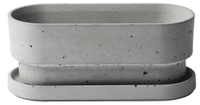
Bentu oval planter, Amazon
Smooth, rounded edges and a slightly rough concrete finish, this planter is ideal for a transitional space. It has a slight industrial feel - modern - but in its subtle color it won't jar against anything more traditional.
7. Layer up your lighting

Lighting is always a critical part of interior design, but it can play a particularly vital role in harmonizing a transitional space. “Lighting is key for transitional style, as it’s key for creating balance,” says Matteo Bianchi. “You have to tick all the boxes when it comes to lighting: soft, accent and artistic lighting. Creating the right shadows are just as important as the light. You need to create an environment that limits flat lighting—that can really ruin your design.”
Matteo Bianchi continues: “It's about the smaller details. For our project [pictured above] we had a specific antique mirror added, which not only helped to compliment the light, but helped to bring out the metallic components within the design.”
Clare Morton agrees that building layers of dining room lighting is the way to go. “I suggest using modern pieces and working with the rule of three when it comes to lighting: add ceiling lights, wall lights and freestanding lamps. The light they emit should be kept soft - no harsh light - to create a cozy scenario for dining. Putting ceiling lights on a dimmer will help to control the mood of the dining room.”
It can also make sense to build your dining room lighting around the dining room table. “If you have a particularly long, rectangular table, spread the light with either a linear chandelier or multiple light sources (odd numbers work better than even numbers),” says Hanna Walter, Product & Creative Manager, Heathfield & Co. “If your table is round or square, a single statement chandelier or a dramatic cluster pendant can’t fail to create a stunning centerpiece.”
8. Let light fittings help set the scene

The lighting fittings and fixtures you choose should also be carefully thought through. In fact, there’s an argument to making this your very first step. “For me, it’s less about the actual light levels than the light fitting itself,” says Christian Bense. “Fitted lighting becomes part of the architecture of a room. There is something about fitted lighting feeling permanent to me that means that it starts to dictate the overall style of a room much the same way a fireplace or the cornice would. I always use the fitted lighting to set the scene, as the first major player in the overall style of the room.”
There is an art to getting this right. “For a successful transitional style, make sure that all fitted lighting balances out the overall style of a room,” Chrisitian continues. "And so, in a trad room, have a contemporary pendant. In a contemporary room, add in something trad etc.”
9. Keep tableware simple

To prevent your transitional-style dining room from feeling too busy, keep any extra decorations as pared back as possible.
“Tableware should be kept simple, with handmade crockery in natural colors, plain cutlery, nothing decorative, and linen napkins,” says Claire Morton. “The dining table and sideboard can be dressed with contemporary, handmade earthenware vases, displaying simple arrangements like twigs or tree cuttings.”
Matteo Bianchi agrees: “Your table dressing should be quite minimal, just a very small centerpiece will do. You want to make sure that the table is not asking for too much attention, that there’s no strong accent.”
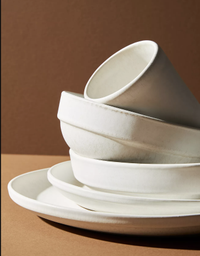
Briar plates, Anthropologie
Currently in the sale, these tactile plates have a handmade feel to them, with slightly worn edges and a speckled finish. They are so much softer than shiny white plates, so much easier to live with and so much prettier on a dining table.
10. Don’t play it safe

Transitional design might demand a great deal of consideration and restraint—but not to the point it debilitates you. “The ‘watch out’ here is to make something so ’safe’ that it doesn’t have any style at all,” says Matteo Bianchi.
“If you’re not daring enough, everything you make will be average. Make sure that you don’t restrict yourself when expressing your personality. While it’s important to make sure the space will be transitional enough to mix different eras and finishes, you need to add a bit of character or there won’t be any personality come through. You need to go for it. All in or nothing.”
Be The First To Know
The Livingetc newsletter is your shortcut to the now and the next in home design. Subscribe today to receive a stunning free 200-page book of the best homes from around the world.
Kate Hollowood is a freelance journalist who writes about a range of topics for Marie Claire UK, from current affairs to features on health, careers and relationships. She is a regular contributor to Livingetc, specializing in reporting on American designers and global interiors trends. Based in London, Kate has also written for titles like the i paper, Refinery29, Cosmopolitan and It’s Nice That.
-
 What are the Most Comfortable Pillowcases? From Temperature Regulating to the Best for Your Skin
What are the Most Comfortable Pillowcases? From Temperature Regulating to the Best for Your SkinWhen you're looking for comfort in your pillowcases, material matters. These are the best you can buy
By Faaizah Shah Published
-
 5 Simple, but Genius Bathroom Layout Tricks That Will Make Your Space Work so Much Harder
5 Simple, but Genius Bathroom Layout Tricks That Will Make Your Space Work so Much HarderSmall switches to how you lay out your bathroom that help make the most of a small space
By Luke Arthur Wells Published

